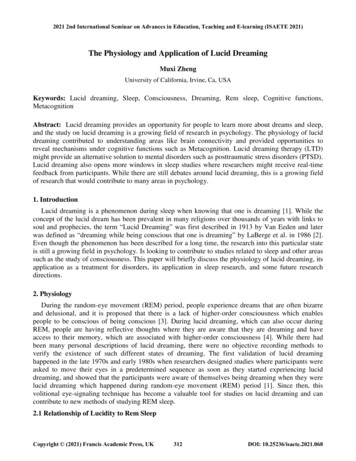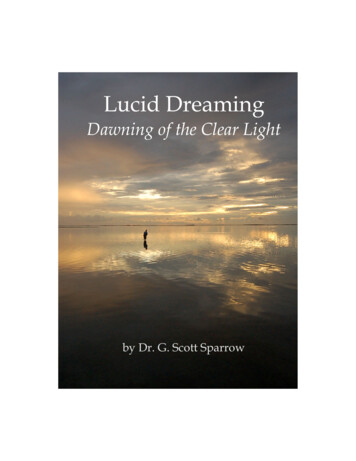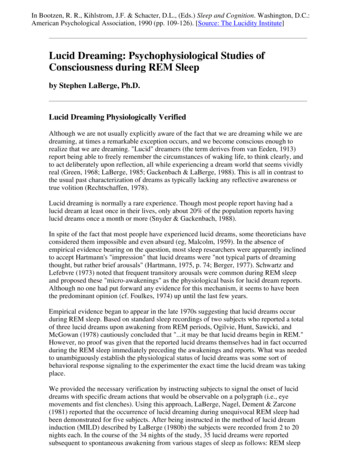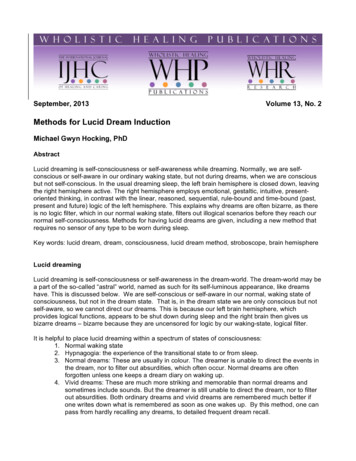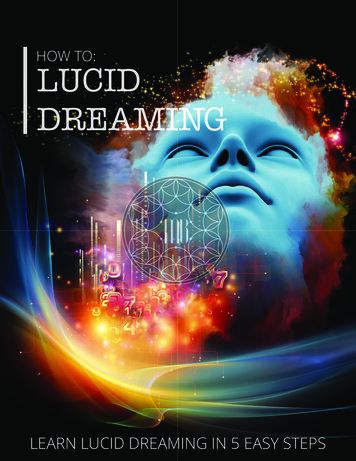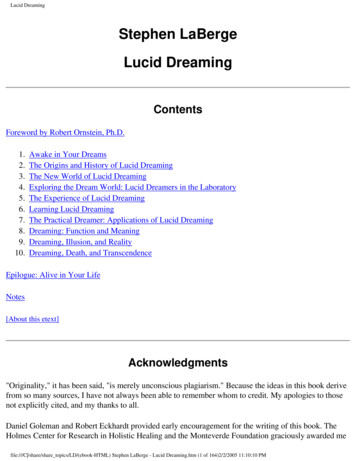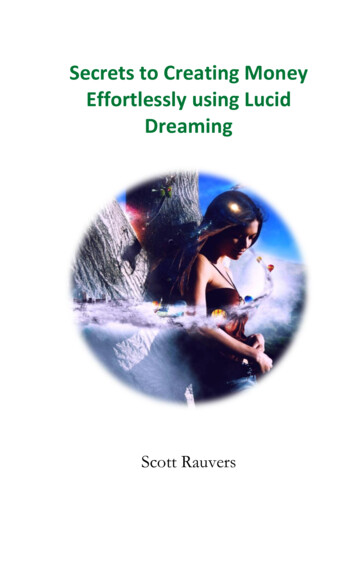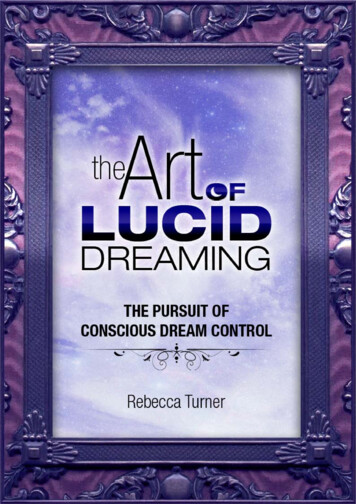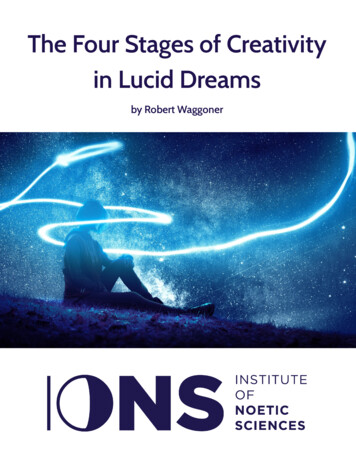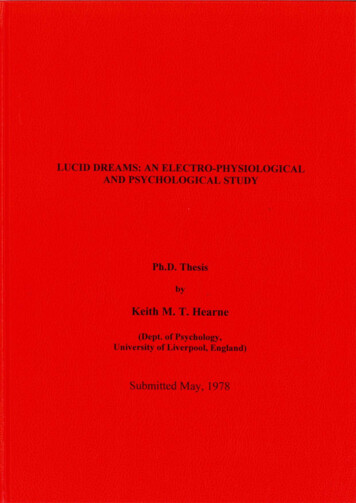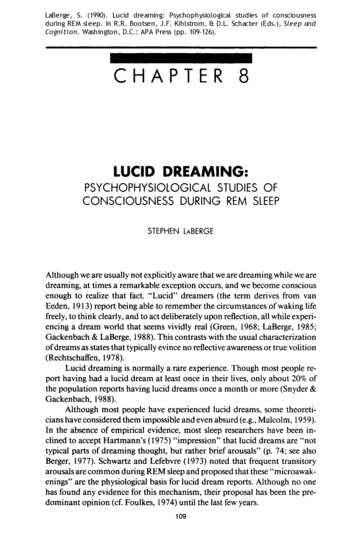
Transcription
LaBerge, S. (1990). Lucid dreaming: Psychophysiological studies of consciousnessduring REM sleep. In R.R. Bootsen, J.F. Kihlstrom, & D.L. Schacter (Eds.), Sleep andCognition. Washington, D.C.: APA Press (pp. 109-126).CHAPTER 8LUCID DREAMING:PSYCHOPHYSIOLOGICAL STUDIES OFCONSCIOUSNESS DURING REM SLEEPSTEPHEN LABERGEAlthough we are usually not explicitly aware that we are dreaming while we aredreaming, at times a remarkable exception occurs, and we become consciousenough to realize that fact. “Lucid” dreamers (the term derives from vanEeden, 1913) report being able to remember the circumstances of waking lifefreely, to think clearly, and to act deliberately upon reflection, all while experiencing a dream world that seems vividly real (Green, 1968; LaBerge, 1985;Gackenbach & LaBerge, 1988). This contrasts with the usual characterizationof dreams as states that typically evince no reflective awareness or true volition(Rechtschaffen, 1978).Lucid dreaming is normally a rare experience. Though most people report having had a lucid dream at least once in their lives, only about 20% ofthe population reports having lucid dreams once a month or more (Snyder &Gackenbach, 1988).Although most people have experienced lucid dreams, some theoreticians have considered them impossible and even absurd (e.g., Malcolm, 1959).In the absence of empirical evidence, most sleep researchers have been inclined to accept Hartmann’s (1975) “impression” that lucid dreams are “nottypical parts of dreaming thought, but rather brief arousals” (p. 74; see alsoBerger, 1977). Schwartz and Lefebvre (1973) noted that frequent transitoryarousals are common during REM sleep and proposed that these “microawakenings” are the physiological basis for lucid dream reports. Although no onehas found any evidence for this mechanism, their proposal has been the predominant opinion (cf. Foulkes, 1974) until the last few years.109
110STEPHEN LABERGELUCID DREAMING PHYSIOLOGICALLY VERIFIEDEmpirical evidence began to appear in the late 1970s suggesting that luciddreams occur during REM sleep. Based on standard sleep recordings of 2 subjects who reported a total of three lucid dreams upon awakening from REMperiods, Ogilvie, Hunt, Sawicki, and McGowan ( 1978) cautiously concludedthat “it may be that lucid dreams begin in REM.” However, no proof wasgiven that the reported lucid dreams had in fact occurred during the REMsleep immediately preceding the awakenings and reports. What was needed toestablish the physiological status of lucid dreams unambiguously was a behavioral response that would signal to the experimenter the exact time at whichthe lucid dream was taking place.LaBerge, Nagel, Dement, and Zarcone (198 1) provided the necessaryverification by instructing subjects to signal the onset of lucid dreams withspecific dream actions that would be observable on a polygraph (i.e., eyemovements and fist clenches). Using this approach, they reported that the occurrence of lucid dreaming during unequivocal REM sleep had been demonstrated for 5 subjects. After being instructed in the method of lucid dreaminduction (MILD) described by LaBerge (1 980c), subjects were each recordedfrom 2 to 20 nights. In the course of the 34 nights of the study, 35 lucid dreamswere reported subsequent to spontaneous awakening from various stages ofsleep as follows: REM sleep, 32 times; non-REM (NREM) Stage 1 sleep, 2times; the transition from NREM Stage 2 to REM sleep, 1 time. The subjectsreported signaling during 30 of these lucid dreams. After each recording, thereports mentioning signals were submitted along with the respective polysomnograms to a judge uninformed of the times of the reports. In 24 cases (90%),the judge was able to select the appropriate 30-s epoch on the basis of correspondence between reported and observed signals. All signals associated withlucid dream reports occurred during epochs of unambiguous REM sleepscored according to the conventional criteria (Rechtschaffen& Kales, 1968).A later analysis extending these data with 2 additional subjects and 20more lucid dreams produced identical results (LaBerge, Nagel, Taylor, Dement, & Zarcone, 1981). LaBerge et al. argued that their investigations demonstrated that lucid dreaming usually (though perhaps not exclusively)occursduring REM sleep. This conclusion was supported by research carried out inseveral other laboratories (Dane, 1984; Fenwick et al., 1984; Hearne, 1978;Ogilvie, Hunt, Kushniruk, & Newman, 1983).Ogilvie et al. (1983) reported that the physiological state preceding 14spontaneous lucidity signals was unqualified REM in 12 (86%)of the cases; ofthe remaining 2 cases, 1 was reported to be “ambiguous” REM and the otherwas reported to be wakefulness. Hearne and Worsley collaborated on a pioneering study of lucid dreaming in which the latter spent 50 nonconsecutiveI am grateful to Ronald Hertel, the Institute for Human Development, the Mericos Foundation, and the Reality Foundation for financial support and to Lynne Levitan for editorialassistance.
Lucid Dreaming111nights in the Hull University sleep laboratory while the former monitored thepolygraph. Worsley reported signaling in 8 lucid dreams, all of which weredescribed by Hearne ( 1978)as having occurred during REM sleep.However, demonstrations that the signaling of lucid dreams occurs during REM sleep raise another kind of question: What exactly do we mean bythe assertion that lucid dreamers are “asleep?” Perhaps these “dreamers” arenot really dreamers, as some have argued in the last century; or perhaps this“sleep” is not really sleep, as some have argued in this century. How do weknow that lucid dreamers are really asleep when they signal? If we considerperception of the external world as a criterion of being awake (to the externalworld), we can conclude that they are actually asleep (to the external world)because, although they know they are in the laboratory, this knowledge is amatter of memory, not perception. Upon awakening, lucid dreamers reporttotal immersion in the dream world and no sensory contact with the external world.One might object that lucid dreamers are simply not attending to theenvironment; rather than being asleep, perhaps they are merely absorbed intheir private fantasy worlds as are those, for example, who are deeply immersed in a novel or daydream. However, according to the reports of luciddreamers (LaBerge, 1980b, 1985), if they deliberately attempt to feel the bedcovers they know they are sleeping in or try to hear the ticking of the clockthey know is beside their bed, they fail to feel or hear anything except whatthey find in their dream worlds. Lucid dreamers are conscious of the absenceof sensory input from the external world; therefore, on empirical grounds,they conclude that they are asleep.Conversely, if subjects claim to have been awake while showing physiological signs of sleep (or vice versa), we might have cause to doubt their subjective reports. However, when the subjective accounts and objective physiological measures are in clear agreement (as they are here), it is embarrassinglyawkward to assert (as some critics have done) that subjects who report beingcertain that they were asleep while showing physiological indications ofunequivocal sleep were actually awake (cf. LaBerge, Nagel, Dement, & Zarcone, 1981).Some critics have suggested that demand characteristics might accountfor our results. It is true that.our subjects were under demand to have, signal,and report lucid dreams, but could demand alone account for their actions ifthey were not lucid in the first place? If they merely unconsciously signaled,we would have found REM periods with signals without subsequent reportsof lucidity, but we did not. If they merely reported having signaled withoutactually having done so, we would have found reports without signals, whichwe did not. Further, by this account, where would the reported and observedsignals have come from?The evidence is clear: Lucid dreaming is an experiential and physiological reality; though perhaps paradoxical, it is clearly a phenomenon of sleep.
112STEPHEN LnBERGEPHYSlOLOGlCAL CHARACTERISTICS OF LUCID DREAMlNGThe preceding studies have shown that lucid dreams typically occur in REMsleep. However, REM sleep is a heterogeneous state that exhibits considerablevariations in physiological activity, ordinarily distinguished by two distinctphases. In its most active form, REM is dominated by a striking variety ofirregular and short-lived events such as muscular twitching, including therapid eye movements that give the state one of its most common names. Thisvariety of REM is referred to as phasic, whereas the relatively quiescent stateremaining when rapid eye movements and other phasic events temporarilysubside is referred to as tonic. On first thought, one might expect lucid dreamsto be associated with decreased phasic activity (Pivik, 1986). However, research described later has shown lucid dreaming to be associated instead withincreased phasic activity.LaBerge, Levitan, and Dement ( 1986)analyzed physiological data from76 signal-verified lucid dreams (SVLDs)of 13 subjects. The polysomnogramscorresponding to each of the SVLDs were scored for sleep stages, and everySVLD REM period was divided into 30-s epochs aligned with the lucidityonset signal. For each epoch, sleep stage was scored, and rapid eye movements(EMS)were counted; if scalp skin-potential (SP) responses were observable asartifacts in the electroencephalograph (EEG), these were also counted. Heartrate (HR) and respiration rate (RR) were determined for SVLDs recorded withthese measures.For the first lucid epoch, beginning with the initiation of the signal, thesleep stage was unequivocal REM in 70 cases (92%).The remaining 6 SVLDswere less than 30-s long and, hence, were technically unscorable according tostandard criteria (Rechtschaffen & Kales, 1968). For these cases, the entireSVLD was scored as a single epoch; with this modification, all SVLDs qualified as REM. The lucid dream signals were followed by an average of 115 s(range 5-490) of uninterrupted REM sleep. Physiological comparisons ofEM, HR, RR, and SP for lucid versus nonlucid epochs revealed that the lucidepochs of the SVLD REM periods had significantlyhigher levels of physiological activation than the preceding epochs of nonlucid REM from the sameREM period. Similarly,H reflex amplitude was lower during lucid than nonlucid REM (Brylowski,Levitan, & LaBerge, 1989).To study the temporal variations of physiology as they correlated withthe development and initiation of lucidity, for each SVLD REM period, thephysiological variables were converted to standard scores and averaged acrossdreams and subjects. Figure 1 shows the resultant mean standard scores forthe 5 min before and the 5 min after the initiation of lucidity. Note the highlysignificant increases in physiological activation during the 30 s before and afterlucidity onset.Physiological data (EM, RR, HR, and SP) were also collected for 61control nonlucid REM periods, derived from the same 13 subjects, to allowcomparison with SVLDs. Mean values for EM and SP were significantlyhigher for REM periods with lucid dreams than nonlucid control REM periods (RR and HR did not differ).
Lucid Dreaming1131.0-0.0-SKIN POTENTIAL2.01.0-0.0--l.O-,-5, , , , , , , , ,: , , , , , , , , , ,-4-3-2-1012345MINUTESFigure 1Grand mean z-scores and standard errors for REM density (EM), respiration rate (RR), heart rate (HR), and scalp skin potential responses (SP) during the 5min before the onset of lucidity (black bars) and the 5 min after the onset of lucidity(white bars). Epochs are 30 s in length and the dotted line represents the signaled onsetoflucidity. Sample sizes vary with variable and epoch, but all values are averaged acrosslucid dreams and subjects.Given the finding that lucid dreams reliably occur during activated (phasic) REM, measures of central nervous system activation, such as eye movement density, should contribute something to the pattern of lucid dream distribution. Because it has been observed that eye movement density starts at alow level at the beginning of REM periods and increases until it reaches apeak after approximately 5-7 min (Aserinsky, 197I), we (LaBergeet al., 1986)hypothesized that lucid dream probability should follow a parallel development. Accordingly, we found that mean eye movement density correlated positively and significantly with lucid dream probability ( r .66, p .Ol).Lucid dreams have most commonly been reported to occur late in thesleep cycle (Green, 1968). LaBerge et al. (1986) tested this hypothesis by firstdetermining for each of their 12 subjects the time of night that divided theirtotal REM time into two equal parts. All but 1 of the subjects had more luciddreams in the second half of their REM time than in the first half (binomial
114STEPHEN LABERGE:'Ii
Lucid Dreaming115test, p .O 1). For the combined sample, relative lucidity probability was calculated for REM Periods 1-6 of the night by dividing the total number of luciddreams observed in a given REM period by the corresponding total time inthe REM stage for the same REM period. A regression analysis clearly demonstrated that relative lucidity probability was a linear function of ordinal REMperiod number ( r .98, p .0001).Lucid dreams are initiated in two distinct ways. Subjects usually reporthaving been in the midst of a dream when a bizarre occurrence causes sufficient reflection to yield the realization that they are dreaming. Less frequently,subjects report having briefly awakened from a dream and then, falling backasleep, directly entering the dream with no (or very little) break in consciousness (Green, 1968; LaBerge, 1985). Here is an example of a wake-initiatedlucid dream:I was lying awake in bed late in the morning listening to the sound ofrunning water in the adjoining bathroom. Presently an image of theocean appeared, dim at first like my usual waking imagery. But itsvividness rapidly increased while, at the same time, the sound of runningwater diminished; the intensity of the internal image and external soundseemed to alter inversely (as if one changed a stereo balance control fromone channel to the other). In a few seconds, I found myself at the seashorestanding between my mother and a girl who seemed somehow familiar. Icould no longer hear the sound of the bath water, but only the roar of thedream sea. (LaBerge, 1980b, p. 85)Note that the subject was continuously conscious during the transitionfrom wakefulness to sleep. This fact suggests that Foulkes (1985) was overstating the case by claiming that it is “a necessary part of the experience we call‘sleep’ that we lose a directive and reflective self. You can’t fall asleep, or beasleep, if your waking self is still regulating and reflecting upon your consciousmental state” (p. 42).Because lucid dreams initiated in these two ways ought to differ physiologically in at least one respect (i.e., an awakening preceding one but not theother), the SVLDs were dichotomously classified as either wake-initiated(WILD) or dream-initiated (DILD), depending on whether or not the reportsFigure 2A typical dream-initiated lucid dream (DILD). Four channels of physiological data (central EEG [C3-Az],left and right eye-movements [LOC and ROC], andchin muscle tone [EMG]) from the last 8 niin of a 30 min REM period are shown.Upon awakening, the subject reported having made five eye movement signals (labeled1-5 in figure). The first signal ( 1, LRLR) marked the onset of lucidity. Note the skinpotential artifacts in the EEG at this point. During the following 90 s the subject “flewabout” exploring his dream world until he believed he had awakened, at which pointhe made the signal for awakening (2, LRLRLRLR). After another 90 s, the subjectrealized he was still dreaming and signaled (3) with three pairs of eye movements.Realizing that this was too many, he correctly signaled with two pairs (4). Finally, uponawakening 100 s later he signaled appropriately (5, LRLRLRLR). Calibrations are 50p V and 5 s.
116 3Iii5STEPHEN LnBERGE
Lucid Dreaming117mentioned a transient awakening in which the subject consciously perceivedthe external environment before reentering the dream state.Fifty-five (72%)of the SVLDs were classified as DILDs, and the remaining 2 1 (28%)were classified as WILDs. For all 13 subjects, DILDs were morecommon than WILDs (binomial test, p .OOO 1). As expected, compared withDILDs, WILDs were more frequently immediately preceded by physiologicalindications of awakening, x2(1, N 76) 38.3, p .0001, establishing thevalidity of classifying lucid dreams in this manner. See Figures 2 and 3 forillustrations of these two types of lucid dream.As was mentioned earlier, momentary intrusions of wakefulness occurvery commonly during the normal course of REM sleep, and Schwartz andLefebvre ( 1973) proposed that lucid dreaming occurs during these microawakenings. However, LaBerge, Nagel, Taylor, Dement, & Zarcone’s ( 198 1) andLaBerge et al.’s ( 1986) data indicate that, while lucid dreams do not take placeduring interludes of wakefulness within REM periods, a minority of luciddreams (WILDs) are initiated from these moments of transitory arousal andcontinue in subsequent undisturbed REM sleep.To summarize, an elevated level of central nervous system (CNS) activation seems to be a necessary condition for the occurrence of lucid dreams.Evidently, the high level of cognitive function involved in lucid dreaming requires a correspondingly high level of neuronal activation. In terms of Antrobus’s (1 986) adaptation of Anderson’s ( 1983) ACT* model of cognition todreaming, working memory capacity is proportional to cognitive activation,which in turn is proportional to cortical activation. Becoming lucid requiresan adequate level of working memory to activate the presleep intention torecognize that one is dreaming. This level of cortical and cognitive activationis apparently available only during phasic REM.PSYCHOPHYSIOLOGICAL RELATIONS DURING REM SLEEPPsychologistsattempting to apply rigorous scientific methodology to the studyof such phenomena as mental imagery, hallucinations, dreaming, and conscious processes in general face a major challenge: The most direct accountavailable of the private events occumng in a person’s mind is his or her ownFigure 3A typical wake-initiated lucid dream (WILD) following a transient awakening during REM. Six channels of physiological data (left and right temporal EEG[T3 and T4;C, reference], left and right eye-movements [LOC and ROC], chin muscletone [EMG], and electrocardiogram [ECG]) from the last 3 min of a 14 min REMperiod are shown. The subject awoke at I and after 40 s returned to REM sleep at 2,realized he was dreaming I5 s later, and signaled at 3. Next he carried out the agreedupon experimental task in his lucid dream, singing between signals 3 and 4, and counting between signals 4 and 5. This allowed comparison of left and right hemisphereactivation during the two tasks (LaBerge & Dement, 1982b). Note the heart-rate acceleration-deceleration pattern at awakening (1) and at lucidity onset (3), and the skinpotential artifacts in the EEG (particularly T4)at lucidity onset (3). Calibrations are 50pV and 5 s.
118STEPHEN LABERGEsubjective report. Unfortunately, subjective reports are difficult to verify objectively, and introspection is far from an unbiased and direct process of observation. Two strategies are likely to increase our confidence in the reliability ofsubjective reports: (a) the use of highly trained (and in the context of dreamresearch, lucid) subjects who are skillful reporters, and (b) the use of the psychophysiological approach, which proposes that the convergent agreement ofphysiological measures and subjective reports provides a degree of validationto the latter (Stoyva & Kamiya, 1968).Indeed, the psychophysiologicalapproach was responsible for the goldenage of dream research in the decades following the discovery of REM sleep(Aserinsky & Kleitman, 1953) and the subsequent association of REM withdreaming (Dement & Kleitman, 1957). Although the psychophysiologicalparadigm of dream research has yielded an abundant harvest for many years(see Arkin, Antrobus, & Ellman, 1978),it possesses a fatal flaw: As long as thesubjects are nonlucid, the researcher has no way of making certain that thesubjects will dream about what the researcher might like to study. Presleepmanipulations producing reliable effects on dream content have not beenhighly successful (Tart, 1988).One can only wait and hope that, eventually, adream report will unearth what one is looking for. This is really no better thana shot-in-the-dark approach, and some researchers have proposed abandoningthe psychophysiologicalmethod in favor of a purely psychological approach.Foulkes ( 1981) wrote that “psychophysiologicalcorrelation research now appears to offer such a low rate of return for effort expended as not to be a wiseplace for dream psychology to continue to commit much of its limited resources” (p. 249). This conclusion may well be justified, but only insofar as itrefers to the psychophysiologicalapproach as it is traditionally practiced, usingnonlucid subjects. The use of lucid dreamers overcomes the basic difficulty ofthe old methodology and may revitalize the psychophysiologicalapproach todream research.The fact that lucid dreamers can remember to perform predeterminedactions and can signal to the laboratory suggested to LaBerge (1980b) a newparadigm for dream research: Lucid dreamers, he proposed, “could carry outdiverse dream experiments marking the exact time of particular dream events,allowing the derivation of precise psychophysiological correlations and themethodical testing of hypotheses” (LaBerge, Nagel, Dement, & Zarcone,1981, p. 727). This strategy has been put into practice in a number of studiesthat are summarized later.How long do dreams take? This question has intrigued humanity formany centuries. A traditional answer is that dreams take very little or no timeat all, as in the case of Maury’s famous dream in which he somehow got mixedup in a long series of adventuresduring the French Revolution and finally losthis head on the guillotine, at which point he awoke to find that the headboardhad fallen on his neck. He therefore supposed that the lengthy dream had beenproduced in a flash by the painful stimulus. The idea that dreams occur in themoment of awakening has found supporters over the years.
Lucid Dreaming119We have straightforwardly approached the problem of dream time byasking subjects to estimate 10-sintervals (by counting “one thousand and one,one thousand and two,” etc.) during their lucid dreams. Signals marking thebeginning and end of the subjective intervals allowed comparison with objective time. In all cases, time estimates during the lucid dreams were very closeto the actual time between signals (LaBerge, 1980b, 1985). However, this finding does not rule out the possibility of time distortion effects under some circumstances.The data reported by LaBerge, Nagel, Dement, and Zarcone ( 1981) andLaBerge, Nagel, Taylor, Dement, and Zarcone (198 1) indicate that there is avery direct and reliable relation between the gaze shift reported in lucid dreamsand the direction of polygraphically recorded eye movements. The results obtained for lucid dreams (see also Dane, 1984; Fenwick et al., 1984; Hearne,1978; Ogilvie, Hunt, Tyson, Lucescu, & Jeakins, 1982) are much strongerthan the generally weak correlations obtained by previous investigatorstestingthe hypothesis that the dreamer’s eyes move with his or her hallucinateddream gaze, who relied on the chance occurrence of a highly recognizable eyemovement pattern that was readily matchable to the subject’s reported dreamactivity (e.g., Rofbarg, Dement, Muzio, & Fisher, 1962).LaBerge (1985) reported related experimentsin which 2 subjects trackedthe tip of their fingers moving slowly from left to right during four conditions:(a) awake, eyes open; (b) awake, eyes closed, mental imagery; (c) lucid dreaming; and (d) imagination (“dream eyes closed”) during lucid dreaming. Thesubjects showed saccadic eye movements in the two imagination conditions(b and d) and smooth tracking eye movements during dreamed or actualtracking (a and c).In another study, LaBerge and Dement (1982b)demonstrated the possibility of voluntary control of respiration during lucid dreaming. They recorded 3 lucid dreamers who were asked either to breathe rapidly or to holdtheir breath (in their lucid dreams), marking the interval of altered respirationwith eye movement signals. The subjects reported successfully carrying outthe agreed-upon tasks a total of nine times and, in every case, a judge was ableto predict correctly on the basis of the polygraph recordings which of the twopatterns had been executed (binomial test, p .002).Evidence of the voluntary control of other muscle groups during REMwas found by LaBerge, Nagel, Dement, and Zarcone (198 1) while testing avariety of lucidity signals. They observed that a sequence of left and rightdream-fist clenches resulted in a corresponding sequence of left and right forearm twitches as measured by electromyograph (EMG). However, the amplitude of the twitches bore an unreliable relation to the subjective intensity ofthe dreamed action. Because all skeletal muscle groups except those that govern eye movements and breathing are profoundly inhibited during REMsleep, it is to be expected that most muscular responses to dreamed movements will be feeble. Nonetheless, these responses faithfully reflect the motor
120STEPHEN LABERGEpatterns of the original dream. Similar observations were made by Fenwicket al. (1984).Following reports of cognitive task dependency of lateralization of EEGalpha activity in the waking state by many researchers, LaBerge and Dement(1982a) undertook a pilot study to demonstrate the feasibility of similar investigations in the lucid dream state. The two tasks selected for comparison weredreamed singing and dreamed counting, activities expected to result in relatively greater engagement of the subjects’ left and right cerebral hemispheres,respectively.Integrated alpha band EEG activity was derived from electrodes placedover right and left temporal lobes while 4 subjects sang and estimated 10 s bycounting in their lucid dreams (marking the beginning and end of each taskby eye movement signals). The results supported the hypothesized lateralization of alpha activity: The right hemisphere was more active than the left during singing; during counting, the reverse was true. These shifts were similarto those observed during actual singing and counting. In contrast, a controlcondition with imagined singing and counting showed no significant lateralityshifts. Because of the small number of subjects, the conclusions of this studymust be regarded as suggestive at best.LaBerge and Dement (1982a, 1982b) noted an important implication oftheir results for the interpretation of EEG alpha activity during REM sleep.Because continuous alpha activity occurs when a subject awakens, sleep researchers have usually assumed that increased alpha activity in the context ofsleep is always a sign of wakefulness or relative cortical activation. The findingsjust discussed suggest the contrary: Alpha activity during REM sleep is, as inwaking, inversely related to cortical activation. When a person awakens froma vivid dream to a dark room, his cortical (at least occipital) activationhas decreased, not increased, with the resultant appearance of elevatedalpha power.In this view, it is a straightforward prediction that occipital alpha powerduring REM sleep will correlate negatively with subsequently reported dreamvividness. This could provide the proper explanation for the findingthat awakenings following REM periods with high levels ofalpha activity are more likelyto yield “thinking” reports than awakenings from low-alpha REM periodswhich yield more “dreaming” reports (Antrobus, Dement, & Fisher, 1964).Sexual activity is a rather commonly reported theme of lucid dreams(LaBerge, 1985; Garfield, 1979). LaBerge, Greenleaf, and Kedzierski (1983)undertook a pilot study to determine the extent to which subjectively experienced sexual activity during REM lucid dreaming would be reflected in physiological responses.Sixteen channels of physiological data, including EEG, electrooculogram (EOG), EMG, respiration, skin conductance level (SCL), heart rate, vaginal EMG (VEMG), and vaginal pulse amplitude (VPA), were recorded froma single subject. The experimental protocol called for her to make specific eyemovement signals at the following points: When she realized she was dream-
Lucid Dreaming121ing (i.e., the onset of the lucid dream), when she began sexual activity (in thedream), and when she experienced orgasm.The subject reported a lucid dream in which she camed out the experimental task exactly as agreed upon. Data analysis revealed a significant correspondence between her subjective report and all but one of the autonomicmeasures; during the 15-s orgasm epoch, mean levels for VEMG activity,VPA, SCL, and respiration rate reached their highest values and were significantly elevated compared with means for other REM epochs. Contrary to expectation, heart rate increased only slightly and nonsignificantly.IMPLICATIONS FOR RESEARCH ONSLEEP AND COGNITIONLucid dreaming presents conceptual difficulties for certain traditional beliefsabout sleep and about the presumed limitations of dream mentation. In acertain sense, the anomalous appearance of lucid dreaming parallels that ofthe state that has been called “paradoxical sleep.” The discovery of REM sleeprequired the expansion of our concept of sleep. The evidence we have reviewedassociating lucid dreaming with REM sleep seems to require a similar exp
Lucid dreaming is normally a rare experience. Though most people re- port having had a lucid dream at least once in their lives, only about 20% of the population reports having lucid dreams once a month or more (Snyder & Gackenbach, 1988). Although most people have
